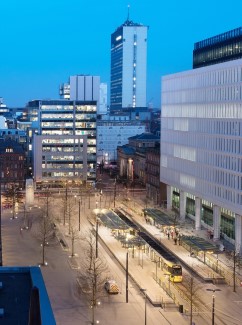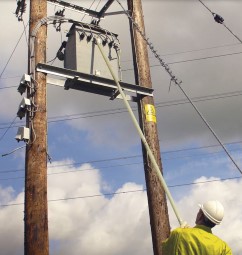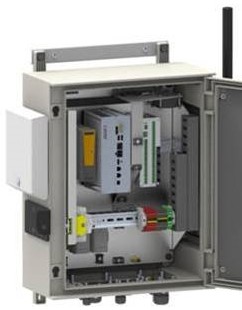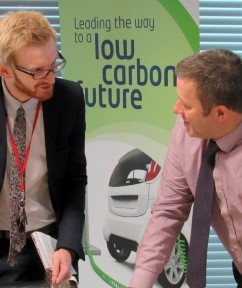Innovation update April 2018
Innovation update April 2018
In this latest issue of our quarterly newsletter, we introduce our new flexible services and provide an update on some of our key projects.
Flexible services will help balance the grid
 As the region’s distribution network operator, it’s our responsibility to plan for the future and seek out smarter, more flexible solutions to meet future demand for electricity.
As the region’s distribution network operator, it’s our responsibility to plan for the future and seek out smarter, more flexible solutions to meet future demand for electricity.
We are utilising a number of innovative techniques to ensure we can continue to deliver an affordable, reliable and sustainable electricity supply for all our customers. Flexible services is one such technique.
Earlier this month we published our requirements for flexible services to manage capacity in key locations across the North West. We’re looking for expressions of interest from companies or individual customers who have the flexibility to generate electricity onto the network, or reduce their demand, in return for payment.
This alternative solution could avoid the need to replace network equipment and reduce costs for all electricity customers.
We hope that by joining forces with generators, storage operators and electricity consumers, we can meet demand in an efficient and more cost-effective way that will help to reduce customers’ bills and protect the environment.
Companies interested in providing flexible services are asked to complete a questionnaire and return it by 29 May 2018. Where there is enough interest and availability we will run a competitive tender for contract delivery in winter 2018/2019 and winter 2019/2020.
For more information on our indicative requirements click here or email us.
We will also be holding a flexible services webinar at 10.30am on Wednesday 25 April 2018. The webinar will consist of a short presentation and will provide an opportunity for participants to ask questions about the service. If you would like to take part in the webinar please register online by Monday 23 April 2018.
Smart Street paves the way for future of electricity network
 We have now completed our pioneering project, Smart Street, which will make the region’s power network more efficient and save money for customers.
We have now completed our pioneering project, Smart Street, which will make the region’s power network more efficient and save money for customers.
By using new technology installed on the electricity network and intelligent software at our control centre, the £11.5 million Smart Street project has successfully trialled new techniques to stabilise voltage, which saves money for customers by making their electrical appliances perform more efficiently.
The ability to stabilise voltage in this way also makes it easier to connect greater numbers of low carbon technologies, such as electric vehicles, heat pumps and solar panels.
During the trials we recorded system data over a two-year period which was analysed by our academic partners. This enabled us to compare Smart Street data with normal network operation and calculate the overall benefits of network optimisation.
The trials were carried out over a two-year period and covered an area served by six primary substations supplying 67,000 customers in Manchester, Wigan, Wigton and Egremont. A series of focus groups were held with a sample of customers served by the trial circuits to understand if the new system affected their electricity supply. All the customers confirmed that they hadn’t noticed any changes.
Smart Street has proved that controlling voltage on our low voltage network brings a number of benefits to customers. It can reduce their electricity bills, reduce carbon emissions and will provide more flexible solutions to help us connect low carbon technologies to the network – all without impacting power quality.
The project closedown report and a series of detailed academic reports will be published here on 30 April 2018.
Celsius starts to cool down substation
 As part of our innovative Celsius project we are installing a range of cooling techniques at 100 substations across the region which will help prepare our network for renewable energy and keep costs down for customers.
As part of our innovative Celsius project we are installing a range of cooling techniques at 100 substations across the region which will help prepare our network for renewable energy and keep costs down for customers.
Over the next 12 months techniques such as improved ventilation, heat extraction fans and alternative kinds of backfill material for underground cables, will help cool down substations and maximise the use of our assets.
The cooling techniques will be installed at 100 of the 520 sites where temperature monitoring equipment was fitted last year. Data from the substations is being used to understand how the environment and temperature affect electrical equipment and how cooling can help release more power onto the electricity network.
At the same time we’ll be carrying out a series of surveys to find out what customers living near the substations think of the new techniques.
Celsius will deliver a co-ordinated approach to managing the temperature of electrical assets in distribution substations and is the first solution of its kind in Great Britain. The project will release additional capacity, reduce long-term costs for customers and avoid early asset replacement.
Respond
 The two-year trials period of our Respond project will be completed this month.
The two-year trials period of our Respond project will be completed this month.
Respond provides an intelligent approach to managing fault current – the instantaneous surge of energy which occurs when we have a fault on the network.
Our intelligent software, the ‘Fault Level Assessment Tool,’ is integrated into our network management system and uses network data to predict fault level in near real time. When fault level approaches or rises above the safety rating of our equipment, the tool ‘enables’ one of three innovative techniques designed to manage fault current safely: adaptive protection, the IS-limiter or the fault current limiting (FCL) service. Respond technology is installed at 14 primary substations serving around 140,000 customers.
Since the trials went live in May 2016, there have been 10 successful operations of the technology in response to a fault. Our adaptive protection installations re-sequence the operation of circuit breakers to reduce fault level. The IS-limiter detects the rapid rise in current when a fault occurs and responds within 1/200th of a second to break the current.
We have held ‘hazard’ workshops to develop safety cases for each of the techniques to demonstrate that they can be used safely and become part of the planning options which can be used by engineers to help manage fault level issues.
Although we have not signed a contract to provide FCL services to a customer, we have designed and constructed an installation that demonstrates how this technique works. Templates for fault current limiting service contracts and findings from our commercial research will be available on our project website in May 2018.
Respond will benefit all electricity customers by helping to avoid or defer traditional, expensive and disruptive reinforcement. This will help keep costs down, reduce carbon emissions and allow low carbon technologies to be connected to the network much more quickly. If rolled out across Great Britain Respond could save £2.3 billion by 2050. The project runs until October 2018.
Tapchanger monitoring
 Our tapchanger monitoring project is set to develop and trial a condition-based system to help us identify when intervention is required for the repair, maintenance or replacement of tapchangers.
Our tapchanger monitoring project is set to develop and trial a condition-based system to help us identify when intervention is required for the repair, maintenance or replacement of tapchangers.
At present tapchangers are monitored on a time-based schedule or by the number of times they operate, and there is no online means to monitor their condition.
We have installed prototype monitoring equipment at three sites to learn and refine our approach before the start of a two-year trial covering a representative sample of our transformers.
During the trial we will collect data from 40 sites to monitor the condition of tapchangers across our network. Analysis of this data will help us to identify the optimum point at which to carry out repairs, maintenance or replacement of the tapchanger and will help us explore other monitoring techniques.
You can find out more about our tapchanger project here which includes a slide presentation given at the recent ENA innovation forum in Birmingham.
Our annual learning event
 On 4 July 2018 we will be holding our annual innovation learning event at the Museum of Science and Industry in Manchester which will follow a similar format to last year’s event.
On 4 July 2018 we will be holding our annual innovation learning event at the Museum of Science and Industry in Manchester which will follow a similar format to last year’s event.
Last year around 80 delegates attended and listened to presentations on our innovation strategy and our portfolio of projects. In the afternoon delegates were able to network with our project partners as part of a mini exhibition and take part in three of four individual breakout sessions.
Please let us know if there’s anything you would like to see included in this year’s event or if you have any feedback on its format.
Useful links
You can find out more detailed information about our strategy and all of our innovation projects using the following links:
 Our innovation strategy, updated April 2018: www.enwl.co.uk/innovation-strategy
Our innovation strategy, updated April 2018: www.enwl.co.uk/innovation-strategy - Our LCN Fund project Smart Street: www.enwl.co.uk/smartstreet
- Our LCN Fund project Respond: www.enwl.co.uk/respond
- Our NIC project Celsius: www.enwl.co.uk/celsius
- Our NIA projects: www.enwl.co.uk/nia
- Meet the Electricity North West innovation team: Meet the team
- The Electricity Networks Association smarter networks portal: www.smarternetworks.org
- The Energy Network Association’s national Electricity Network Innovation Strategy published in March 2018.
Or contact us at innovation@enwl.co.uk.
If you would like to find out about other Electricity North West projects and events please register for our stakeholder newsletter.